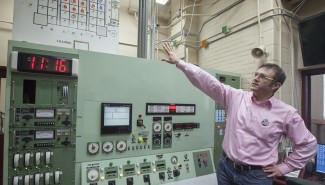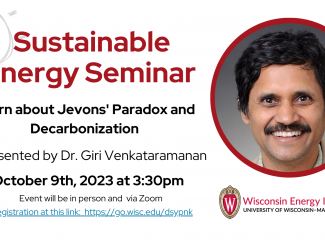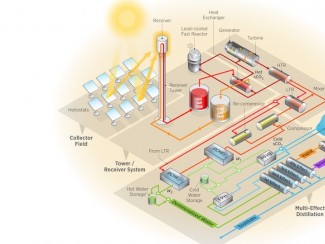
‘Nuclear’ is a powerful word that evokes images ranging from energy production to scheming Bond villains. Nuclear energy provides 70 percent of low-emissions electricity in the United States, yet there is much academic, social, and political debate concerning its safety and sustainability.
This intersection of science and society fascinates Paul Wilson, a professor of engineering physics at the University of Wisconsin-Madison. Wilson, who is also a member of the Wisconsin Energy Institute (WEI) governance committee, is one of a small number of researchers treading the cusp of interdisciplinary boundaries to investigate the potential impacts—both scientific and social—of next-generation nuclear energy systems.
“We’re covering new ground by combining engineering expertise and the social sciences to better understand exactly what people want to learn, and how we can express the costs and benefits of nuclear energy systems in a way that has meaning for them,” Wilson says.
Wilson is working with a team of social science researchers and visualization experts to create a next-generation fuel cycle simulator (NGFCS). Their goal is a SimCity-esqe modeling tool that will help federal decision makers and other stakeholders understand the effects of advanced nuclear fuel systems on economics, environment, human health and geopolitics.
“If you get 50 people together, they'll have 75 different ideas for reactor designs, processing schemes, and ways to build an entire system,“ Wilson says. “We are developing this simulation to help people understand the impacts of these different system configurations as measured by the things that they care about.”
Dominique Brossard, a professor in UW-Madison’s Department of Life Sciences Communication and one of the world’s foremost science communications experts, leads the arm of the project that focuses on identifying key stakeholders and determining what kinds of information about nuclear systems they find most useful.
“Different audiences come to the table with their own values and knowledge, so we have to think in terms of multiple ‘publics,’” she says. "We need to find out how people form opinions, and how to engage them in a meaningful way.
In existing nuclear power systems, energy from fission reactions—usually the splitting of uranium nuclei—is used to heat water into steam, which then drives a turbine to generate electricity. If this process sounds familiar, it could be because coal plants work in much the same way—they just use a different power source.
Unlike coal plants, the clouds billowing from nuclear plants come from cooling towers that expel water vapor, rather than smokestacks that pump out heat-trapping greenhouse gases. But despite their lack of emissions, many issues dog the advancement of nuclear technologies, including whether they would be cost effective and how waste products should be managed.
Modeling the entire nuclear fuel cycle from a socioeconomic and political point of view will allow us to be faithful to the correct physics, while also providing insight for policymakers.
Paul Wilson
Currently, researchers are developing advanced next-generation systems that would split spent nuclear fuel into different chemical components, some of which could be returned to the reactor for another round of energy extraction. In modeling these systems, one of the priorities for Wilson and his colleagues is maintaining scientific accuracy while adding human behavior into the mix.
The idea behind their unique simulation is that in order for nuclear energy technologies to advance, scientists and engineers need to understand not only atomic particles, but people as well.
“We want to have every facility in the global nuclear fuel cycle modeled as an agent in the simulation,” explains Wilson. “Modeling the entire nuclear fuel cycle from a socioeconomic and political point of view will allow us to be faithful to the correct physics, while also providing insight for policymakers.”
In her research, Brossard has found that perceptions of technologies like nuclear energy tend to be guided by pre-existing values, and that while most people get their science and technology information from the mass media, facts do not dictate people’s opinions. Thus, to some degree, the NGFCS project’s success will depend on the researchers’ abilities to check preconceived ideas about what people want and believe at the door.
“We’d like to separate the debate over the physical modeling of [nuclear energy] systems from the debate over the values we use to assess those physical results,” Wilson says.
Funded by the U.S. Department of Energy, the NGFCS project represents the kind of cross-disciplinary research that the WEI promises to support as the new “catalytic home” of energy innovation at UW-Madison.
“It will be very interesting to produce an instrument that allows us to see nuclear energy systems through the eyes of people in many different fields,” Brossard says.




